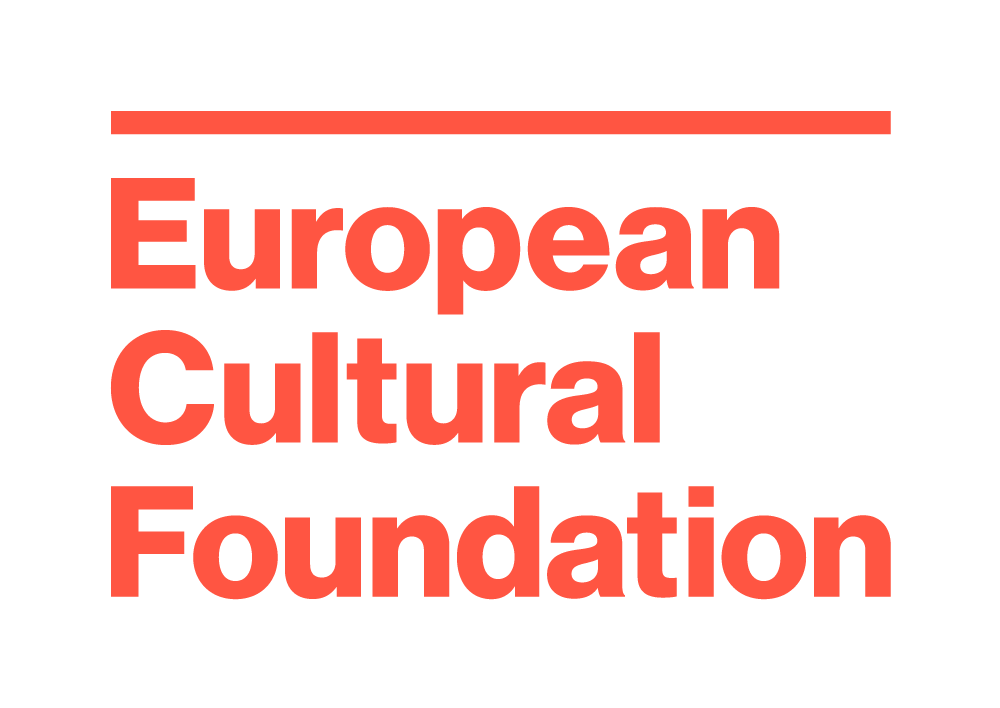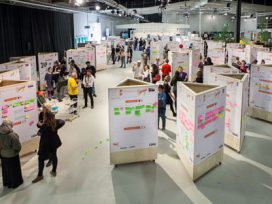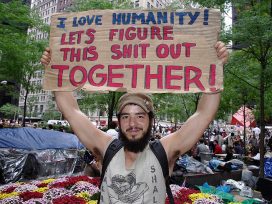Digital solidarity
As the culture and the institutions of the Gutenberg Galaxy wane, Felix Stalder looks to commons, assemblies, swarms and weak networks as a basis for remaking society in a more inclusive and diverse way, which expands autonomy and solidarity at the same time.
Over the last two decades, the Internet has been a laboratory for social innovation. One of the most unexpected collective discoveries has been the existence of another mode of organization to achieve large-scale co-ordination. This mode relies neither on the market, where price signals perform important co-ordinating functions horizontally (as Friedrich Hayek famously stated), nor on public and private bureaucracies, where commands facilitate vertical co-ordination.1 Rather, it relies on voluntary co-operation to enhance the use value of a shared resource. Yochai Benkler dubbed this mode “commons-based peer production.”2
While not all forms of co-operation need be beneficial to society at large, the structural experience of co-operation is a key element in the political project of strengthening social solidarity. This solidarity is more than an empty slogan, it is grounded in concrete, everyday experiences, renewed through collective action and guided by the conviction that one’s own personal goals and aspirations cannot be achieved against others, but with and through them. Such solidarity, embedded in new narratives and creating new, shared horizons for action, can provide the basis for novel cultural, economic and political forms. It isn’t restricted to the Internet. The same dynamic can help to re-evaluate very old forms of organization based on commons that existed in parallel to the dominant modes of prices and commands, since pre-modern times, but were often regarded simply as leftovers, as areas where modernity never bothered to show up, or simply ignored by mainstream theories because they did not fit into any of the dominant theoretical narratives centring around the capitalism/socialism divide. Commons are not capitalist, but also not anti-capitalist. They are, first and foremost, a-capitalist. A tenuous position.
Forms of Solidarity
The most comprehensive new formations for organizing solidarity are developed through the renewal of the idea and practice of the commons or commoning. These are organized, long-term processes, by which a group of people manages a physical or informational resource for joint use. However, this is not the only form that can be distinguished in an admittedly schematic inventory of forms. Besides the commons, there are: assemblies, non-hierarchical, usually physical gatherings focused on consensus-based decision making; swarms, ad hoc, self-steering collective actors; and weak networks, groups constituted by extensive, yet casual and limited social interaction.
Commons
Commons are long-term social and material processes. They cannot be created overnight and in order to become meaningful, they must exist over an extensive period of time. That means that they require some kind of institutional framework that is both durable and flexible enough to meet changing demands and circumstances. There is no single model for institutions of the commons. On the contrary, it is one of their characteristics that they are sensitive to the particulars of the resource held in common and the composition of the group that manages this resource for its use value, and the general context in which the commons exist. Consequently, Elinor Ostrom (1933-2012), the leading scholar on the commons, explicitly avoided building an institutional model of the commons. Rather, she identified a number “design principles”, or general characteristics, that underlie what she called “long-enduring common-pool resource institutions”.3 According to her influential account, commons usually define and limit membership in the group that holds and manages the resource. This is more important in cases of physical commons, where there is danger of the resource being overused (the infamous “tragedy of the commons”), than in “non-rivalrous” digital resources which cannot be depleted. But, even in the latter case, there are usually conditions one needs to meet before being able to access the resource, such as accepting a free licence or adhering to community rules. Inside the group, there is often a kind of hierarchy based on a meritocratic principle, meaning that those who contribute more to the commons can usually use more of the resource (in the case of physical commons), or have a greater say over its development (in case of digital resources). In the case of digital commons, the meritocratic element helps to address the fact that the main challenge is not overuse but under-provision. Making sure that those who contribute most can determine the course of development helps to keep this crucial group of people inside the commons, which is valuable for everyone, thus their authority is usually not contested.
Among the most important characteristics of commons is that they have some mechanisms for decision-making, which involve the members of the commons in a comprehensive way. This is the essential element of self-government: the establishment of the rules that govern the commons by the people in the commons. This goes far beyond simply making a choice among options determined by outside parties. Commons are not marketplaces without money. The relevant choices to be made here are collective not individual ones. Since establishing and maintaining rules is never a friction-free process, Ostrom points to the need to monitor compliance from within the commons and establish a system of graduated sanction, so that small violations can be sanctioned lightly, whereas substantial violations can trigger substantial consequences that can go as far as the expulsion of a person from the commons. Of course, inside the commons there are also conflicts that cannot easily be resolved by adherence to rules, so mechanisms of conflict resolution are required. Many of the problems within Wikipedia, for example, can be related to the fact that there is no functional way to resolve conflicts. They are often simply resolved by the fact that one party is more enduring than the other, or through decisions, such as banning certain contributors, that can appear extremely arbitrary.
Finally, no commons exist in a social void. They are always part of larger social systems, which are usually oriented towards market exchanges or state control and thus are often hostile towards commons practices. Already simple recognition of the rights of the people to manage a resource as a commons and regulate their own affairs is politically contentious. But without it, the commons remains very vulnerable to expropriation from third parties. This is most problematic in the context of indigenous commons and the pressure to privatize resources.
Ostrom highlights that commons are untouched by markets or states, but remain a means to engage and confront them and to force them to operate, or at least regulate, differently. The neo-anarchist approaches currently popular on the Left are thus short sighted. Their power lies in pointing out the need to develop functioning alternative institutions, but they are unable to articulate a strategy of how to engage with the state, and how to inscribe new agendas and new orientations into state institutions. Stefan Meretz, for example, summarizing ten years of debates within the Oekonux project claims that “commons-based peer production does not require to articulate people’s needs in the form of opposing interests and thus is beyond politics”.4 If one understands politics as the mediation of opposing (class) interests and if one looks only at the social dynamics inside the commons, this might be correct. But it is an entirely inadequate way to frame the relationship between a commons and its wider environment. The state and its coercive laws create highly differentiated sets of possibilities, reflecting strong market oriented interests, interests that won’t disappear by simply ignoring them.
This problem is, perhaps, related to an unfortunate blindspot in existing commons research. Very little attention has been placed upon the relationship between commons and the wider social context, namely, state and markets. Elinor Ostrom, for example, only studied commons that have emerged organically from the bottom up. Thus, questions of context and embedding were already somehow solved (otherwise the commons would not have existed in the first place). But today since we are confronted with a neoliberal downsizing strategy that has opportunistically seized upon the concept of the communal self-reliance, named big society in the UK or resilient communities in the US, it is important to add two more “design principles”: adequacy of resources and a shared cultural horizon. The first means that within the community the material resources to organize a commons should be available. It is cynical to demand self-organization from communities where the preconditions to do so are not available. So, in cases where the resources are not adequate to begin the process of commoning, one needs to ask how state and markets need to be transformed in order for resources to become adequately available to the commons. This, again, points to the need to engage with the state more explicitly.
But not only do material resources need to be available, there also needs to be something like a shared cultural horizon against which trust can be deepened and decision making becomes possible. Without a rough but shared understanding of the nature of the problem and of desirable solutions no commons will ever be created. The necessity of the latter two conditions – which are usually taken for granted in the commons literature that focus on commons that already exist – may help to explain why it is so difficult to create new commons on a larger scale, despite the growing interest in the concept from NGOs and an explosion of activism creating new small scale commons, some physical and local (such as community gardens), others informational and distributed online.5
Assemblies
It is always difficult to build long-term institutional structures. But often, this is not necessary, at least not in the beginning. On a somewhat shorter timescale assemblies provide a part of, if not the, social core of the current wave of protests that began in the Mediterranean in late 2010, reached the US at Occupy Wall Street in September 2011, and flared up again in Turkey and Brazil in June 2013. Assemblies are usually physical gatherings. This requires access to a suitably large, open meeting space. That space has often been created through the occupation of squares, parks and other public spaces. These occupations operate on a symbolic and pragmatic level at the same time. They are as much about re-appropriating public spaces at the heart of the city, as they are about creating spaces of shared experiences and collective deliberation, thus translating and extending the networked experience of shared, autonomous communication and community-building back into physical space.
Assemblies are based on a tradition of participatory democracy, but they are also developed in opposition to what is seen as the shortcomings of direct democracy, such as an overreliance on voting and an orientation towards majorities. In contrast, assemblies rarely vote. They are oriented towards consensus while, at the same time, allowing for the greatest multiplicity of voices. At times deliberate measures are taken to enable this diversity against the tendency of the most forceful or organized groups to dominate open and relatively unstructured discussions. One way has been to adopt a culture of instant feedback through hand signals, turning passive listeners into active commentators without interrupting the flow of the single voice whose turn it is to speak. A more radical expression of the same idea is the so-called “human mic”, by which the audience repeats and therefore amplifies the voice of the speaker. Initially developed to overcome regulatory restrictions banning loudspeakers from Zuccotti Park, the local focal point of the Occupy Wall Street movement, it has turned into much more. It not only allows a single speaker without technical equipment to address a larger crowd, but also avoids the problem that positions of authority become established through technology. Speaking and listening comes into a new relation as both become weak yet active. Also, the Occupy Wall Street assemblies used, as a method to increase diversity, the progressive stack. A stack is simply the list of people signed up to take a turn to speak. It’s the main way to organize the flows of speakers in the assembly. To avoid this list being filled with people who are usually encouraged to speak in public (say, white, educated men speaking in their native language), the stack ranks speakers from marginalized groups (say, women, people of colour, non-heterosexuals) higher in the list. This has deeply affected the character and self-understanding of the movement. As the first declaration was being prepared by Occupy Wall Street, the initial draft opened with the following line:
As one people, formerly divided by the colour of our skin, gender, sexual orientation, religion, or lack thereof, political party and cultural background, we acknowledge the reality: that there is only one race, the human race.
This was quickly called out as a problematic papering over existing divisions – even within the movement. After a contentious debate that was shaped, among others, by a group of people who nicknamed themselves “POCcupiers”, (People Of Colour) a different wording was adopted.6 The final declaration, adopted on 29 September 2011, reads: “As one people, united, we acknowledge the reality: that the future of the human race requires the co-operation of its members.”7
Even though assemblies can be a cumbersome process and the case of the wording of the declaration shows that, for all its strengths, the need to build consensus can lead to weak solutions – divisions are not spelled out but only indirectly acknowledged as diversity (“members of the human race”) – they have been crucial to the entire process, and the building of real solidarity that underlies it. For David Graeber, for example, it was this radically utopian and immediately practical break with the established institutional forms of protest and resistance, and the resulting refusal to engage in the standard modes of interaction with the dominant powers (by way of demands and delegates), that allowed to movement to spread so quickly and deeply. Whereas other, more conventional attempts to organize against the crisis did not gain much traction.8 The leaderless structures of assemblies, the ease with which people shift between roles of speaker and listener, the way in which discussions are archived publicly (if they take place online) or minutes are taken and made available publicly, reflect a by now widely shared Internet culture of transparency and flexible participation. It is no coincidence that the last of the eight principles of solidarity, articulated through consensus by the New York General Assembly takes up the quintessential hacker demand: “making technologies, knowledge, and culture open to all to freely access, create, modify, and distribute.”9 The ease by which experiences and debates are shared and condensed, and by which the learning of one group can be made available to others, locally and globally, helps to expand the potential of assemblies beyond spaces of experience to ways of pragmatic organizing.
Commons and assemblies share, most notably, a focus on rough consensus, rather than majorities, and consequently a reluctance towards voting, which usually serves as a means to produce majorities. In relation to commons, Ostrom explains this reluctance the following way:
substituting a simple majority vote for a series of long discussions and extensive efforts to come close to a consensus before making decisions that commit a self-governing community, may lead to those in leadership positions simply arranging agendas so that they win in the short run. But as soon as rules are seen as being imposed by a majority vote rather than being generally agreed upon, the costs of monitoring and enforcement are much higher. The group has lost quasi-voluntary compliance and must invest more heavily in enforcement to gain compliance.10
Thus, what might be efficient in the short term could be corrosive in the long term. Thus it is no coincidence that assemblies, rather than simple voting procedures, play a key role in the governing of many physical commons. In digital commons, there is also a general rejection of voting as a means of decision-making. The principles of the hacker culture, which informed much of the early Internet, are deeply inscribed in its technological infrastructure, and still shape the free and open source software world, were summarized by Arthur D. Clarke, then at the Internet Engineering Task Force (IETF), in 1992, when he famously declared: “we reject: kings, presidents and voting. We believe in: rough consensus and running code.”11 Majorities are not a good way to run voluntary associations, since they always run the danger of alienating the minority. In the case of online projects, it is very easy to leave and reconvene somewhere else. Hence, the rejection of voting in online communities is not related to the increased cost of monitoring compliance, but to the danger of the defection of contributors. Thus, there is a strong incentive for all participants to reach some form of consensus that ensures that the maximum number of contributors remain in the project.12 Only in extreme cases where this is not possible, despite lengthy discussion processes, do splits in the community (“forking”) indeed occur.
Swarms
If the constant threat of decomposition lurking in the background is what keeps online communities committed to the complex task of establishing “rough consensus”, then it is continuous oscillation between centripetal and centrifugal dynamics that lies at the very heart of the third new form: swarms. A contemporary social swarm consists of independent individuals who are using simple tools and rules to coordinate themselves horizontally to pursue a collective effort. “Anonymous” is probably the most spectacular case of digital swarming, but it lies at the heart of most stories about how the Internet enables spontaneous collective action through forms of “organizing without organization”.13
It is this collective effort, defined explicitly and pursued consciously by the participants themselves, that differentiates these swarms from other forms of emergent mass behaviour that have fascinated and frightened theorists of mass politics since Gustave Le Bon (1841-1931). Thus, a contemporary swarm is a coordinated mass of autonomous, self-conscious individuals. They do not, as Le Bon and his followers ever since have suggested, substitute their conscious activity as individuals (reason) for the unconscious action as a crowd (emotions).14 Rather, they constitute a self-directed, conscious actor, not a manipulated unconscious one. One reason for this is that these new swarms are joined consciously one by one, rather than arising out of pre-existing crowds of people, and that they are maintained through explicit acts of horizontal, autonomous communication. It is misleading to continue to treat the two states of aggregation – collective and individual – as dichotomous, even when claiming that swarms such as Anonymous do not represent the “end of subjectivity”. Instead, what arises is a new form of collective subjectivity without individual identity.”15
This is the outside view that only sees the mask. Seen from the inside, this looks very different. As Rick Falkvinge, the founder of the Swedish Pirate Party, pointed out:
the complexity comes with the meritocracy that makes up how the Swarm operates and decides on courses of action as an organism. As all the people in the Swarm are volunteers – they are there because they think the Swarm can be a vehicle for change in an area they care about – the only way to lead is by inspiring others through action.16
Thus, the strength of the swarm comes from the number of individuals who join it and the focus it brings to their distributed, independent efforts. All swarms always start in the same way: a call for action and the availability of some resources to start acting right away. Social media researcher Clay Shirky identified three main requirements that must come together for such loosely organized cooperation to emerge: promise, tool and bargain.17 The promise is the call for action. It need not only to be relevant to a critical number of people but also credibly attainable. The tools are the resources and strategies available to work towards the promise. Today, tools to co-ordinate the efforts of volunteers are readily available online and different tools, such as online forums, wikis or chats, are capable of sustaining different social dynamics on all scales. The “bargain” points to conditions one has to accept when entering the collective space of action. Only when the three dimensions match for a large number of people – the promise being attractive, the tools available, and the bargain not too onerous – does co-operation get underway. Over time, each of the three dimensions can change, and the swarm can grow, change direction or fall apart. For such swarms to be more than random and short-lived affairs, there needs to a fourth element, a common horizon, which, as cultural critic Brian Holmes explains, “allows the scattered members of a network to recognize each other as existing within a shared referential and imaginary universe.”18
It is through this common horizon that we can also differentiate politically between different swarms. While all swarms are based on some acts of social solidarity, it does not mean that they are always socially beneficial.
Weak networks
Quantitatively speaking, weak networks – groups held together by casual and limited social interaction – are the most important of the new social forms. They are often created by using technologies labelled as “social web”, or “web 2.0”. These labels are unfortunate, because the important parts are not the technologies but the social formations and cultures that are built by using them. Due to their immense popularity, weak networks are setting a new baseline of what (inter)personal communication means today and they shape the new “common sense” about social interaction. They are the new normal. Aggregated users and their actions are measured in the billions, Facebook alone announced one billion active users in October 2012.19 By the end of that year, between one third and a full half of the population in developed and many developing countries have been using social networks regularly. A large number of them have indicated that they are using these networks not just to share information about personal or “community issues”, but also to share information about “political issues”, meaning they are both a means to organize one’s personal life as well as a means to engage with the world at large and to remake the world according this changed baseline of personal experience.20
Despite the size of these social networks, and the very considerable resources and influence of the companies that own the related network infrastructures, I want to call them “weak networks” to highlight two aspects. First, these platforms excel at initiating and maintaining a large number of sporadic, limited interactions. These create what Marc Granovetter, over 40 years ago, named “weak ties”.21 Most people would agree that being a “Facebook friend” with someone means very little compared to a conventional, intimate friendship. This, of course, does not mean that an intimate friend cannot also be a Facebook friend, but that strong relationships tend to be built outside of Facebook and the latter is merely a small strand within this. But “weak” in this sense does not mean without consequence. On the contrary, Granovetter, in his foundational paper on network sociology, showed that it is precisely the information shared through “weak ties” that helps people to orient themselves in the larger society they live in. The reason being that people who share strong ties share a lot of knowledge about the same (small) aspects of society they know very well. Hence there is very little new information to be shared between them, but the information that is shared is very rich in meaning. Strong ties produce closely meshed, enduring groups, for the better or worse. The number of strong ties a person can maintain is usually very small, hence these groups tend to be small. Weak ties, on the other hand, allow the accommodation of lots of difference, because the areas of shared understanding and knowledge are, by definition, limited. Hence a lot of new information can pass through these connections, simply because the differences between the two parties connected can be significant and the number of weak ties a person possesses can be very large.
One of the most important functions of weak ties is to connect closely meshed groups to one another and thus allow information to spread across a wider social range. They create “small worlds” insofar as they create structural conditions to share information efficiently across large social distances. The famous six degrees of separation example, first imagined by Hungarian playwright Frigyes Karinthy in a short story entitled “Chain Links” (1929) and first empirically tested by Stanley Milgram in 1967, illustrates this very well.22 Seen from the point of view of network topology, it is assumed that two random people are connected to each other by an average of six nodes, these are six intermediary connections. This is a small number and cause of concern for epidemiologists. In social experience, however, a friend of a friend of a friend (two degrees of separation) is already a perfect stranger. This number, of course, is not a static natural phenomenon, but a function of network topology. Thus it is not surprising that within highly connected networks, this number is decreasing as the degree of connectivity is rising. Facebook announced in late 2011 that “as Facebook has grown over the years, representing an ever larger fraction of the global population, it has become steadily more connected. The average distance in 2008 was 5.28 hops, while now it is 4.74”.23 The “price”, of course, is that social meaning of what counts as a “friend” has decreased so that by now, a Facebook friend of a Facebook friend, is – on a conventional social level – a stranger. Yet it is precisely a sense of connectedness to “quasi-strangers” that Facebook produces, and this is what allows weak networks to spread and what enables people to experience the world differently.
The intriguing suggestion made by Granovetter was that the study of weak links offered a perspective to address one of the vexing problems of social theory, the connection between micro-level interactions and macro-level events. It is through weak ties, he argued, that information travels across society at large and thus creates certain types of informal macro-level coordination.24 This has nothing to do with digital networks per se, but the new technologies of connection make it possible to maintain a great number of weak ties very efficiently. Managing very extensive networks used to be a privilege of the elites who commanded a very expensive infrastructure for this purpose, which included international meetings, conferences, clubs and support staff. Quantitatively speaking, this has been democratized. One no longer needs a personal secretary to remember the birthdays of 500 people. This has created many more small worlds (large but densely connected clusters), it has thus made the world as a whole much smaller, and affects the many ways micro-level interactions create macro-level events and vice-versa.
At the same time, it may well be that these “small worlds” are again becoming more isolated from one another by way of the “filter bubble”. The filter bubble is the effect of new algorithms that try to personalize the information flows by privileging information travelling over certain types of channel. In principle, they are favouring information coming through strong rather than weak ties, because strong ties indicate relevance. Yet, in practice, there are numerous signs that commercial communication is being privileged over non-commercial. Increasingly, commercial messages (“promoted posts” as Facebook calls them) are required to pass through the filtering algorithms.25 This would suggest that weak networks do integrate and fracture the social world at the same time, creating a deeply integrated, yet highly non-linear, social geography.
The presence of the new filtering algorithms highlights the second reason why it is useful to think of social networks as weak networks: the very limited degree of control users have over the tools through which they build their networks and thus over the types of social relationships they can build. While there is no direct, determining relationship between a tool and the social dynamics it can enable, tools and their particular, often subtle, designs do matter. This is particularly important in the case of the current crop of tools for creating and maintaining weak networks that are constructed for a dual purpose. One purpose is that of attracting users to share information with other people. In order to be successful, these tools need to offer something that is really useful to people. People are not duped into creating weak networks and they would stop using them if they did not offer tangible benefits. The ability to share information and build extensive social networks is of great, immediate value to most people. Yet, these tools are, of course, equally – arguably even primarily – constructed to create profits for investors who financed it and thus shaped it from the beginning. As such, these tools enable the transformation of social value (created between users) into commercial value (created by and on behalf of the owners of the platforms).
At the heart of most digital social networks lies a tension between the horizontal exchanges through the users’ weak ties to each other, and the vertical architecture of the platforms themselves. This techno-structural element in itself is not necessarily problematic. It could be seen simply as another instance of the typical layering of network architecture that often combines decentralization of one layer with centralization of another, making discussion of whether “the Internet” is a centralized or decentralized technology meaningless. Indeed, Wikipedia is an example where decentralized elements (the editing of individual articles, different language versions etc.) and centralized elements (the server infrastructure, the foundation) co-exist productively. However, Wikipedia is better characterized as a commons in which the contributors exercise a large measure of control over the institutional framework of their cooperation, which doesn’t serve any other purpose than to support their efforts.
In most weak networks, on the contrary, the tension arises from the deliberate congruence between two architectural designs (horizontal for the users, vertical for the owners of the infrastructure) and two value orientations (social value for users, commercial value the owners). During the first half-decade of the existence of most of these platforms, roughly between 2005 and 2010, this tension was barely noticeable, since the social took precedence over commercial values. In these years, the main goal of such platforms was to attract users. Business models were not yet implemented. Most of these services did not generate profits and investors were willing to delay short-term returns in hope of even bigger returns further down the line. This has changed since all these platforms were either acquired by publicly traded companies or have become publicly traded themselves. Now the tension has become much more visible. In just a single week towards the end of the 2012, Facebook, for example, announced that it would grant itself an unlimited licence to commercially exploit content generated by the users of one of its subsidiaries (the photo-sharing service Instagram). The intention to commercially appropriate material produced for its social value was so overwhelmingly obvious that users revolted almost immediately. To avert a public relations disaster, the changes in the terms of use were cancelled, but it was made clear that the service “was created to become a business. Advertising is one of many ways that [it] can become a self-sustaining business, but not the only one.”26 Whether this amounts to an apology or a threat is probably beside the point. The point being, the clear and simple statement of a basic fact: what is social interaction for some, is a business for others.
To capture this tension Tiziana Terranova coined the term “free labour”, which she situates at
the moment where this knowledgeable consumption of culture is translated into productive activities that are pleasurably embraced and at the same time often shamelessly exploited.27
In contrast to phenomena such as crowdsourcing – where a large number of independent would-be contractors are made to compete against each others for short term work – the transformation of value within and through social networks, does not easily fit the model of exploitation as proposed by labour theory.28 What is created here are not new sweatshops but rather new pastures from which to extract rent. As Steffen Boehm explains:
In controlling social networking sites, companies like Facebook are able to charge a rent for access. This is not a direct rent […] because Facebook is free to use. Rather, the rent is extracted as a tithe […] so that, whilst consuming (freely) on Facebook, the user is simultaneously working (freely) for Facebook, producing themselves and their friends as audience and producing data that Facebook can commodify and sell. [….] Facebook does not reap a profit merely from organizing the paid labour of its relatively few employees […], but extracts a rent from the commons produced by the free labour of its users.29
But this capture of the social process is not all. Increasingly, there is also direct rent. The ability to extract such rent, as David Harvey explains,
arises because social actors can realize an enhanced income stream over an extended time by virtue of their exclusive control over some directly or indirectly tradable item which is in some crucial respects unique and non-replicable.30
In the case of Facebook and others, this “tradable item” is the weak social ties. The aforementioned tendency towards “promoted posts” is perhaps the clearest indication for the extraction of direct rent, being rather similar to the ability of the owner, of say a bridge, to extract rent by setting up a toll both. The list of attempts to extract rent is near endless as the demands of investors to realize returns, either directly or through the rise of stock prices.
If this tension spells doom for social networks – imploding as users feel alienated by the commercialization of their social spaces – or, if this represents a sustainable extension of the commercial logic even deeper into the social fabric remains to be seen. For now, they contribute to establishing co-operation and sharing, in some limited, possibly distorted way, as a normal social experience within a society otherwise dominated by competition and atomization in the markets.
So What?
The phenomena described here are marginal, even if they can mobilize swarms of hundreds of thousands of people. Even the rise of weak networks as the new normal of social communication is still relatively shallow and superficial, compared to the deep institutions that continue to exert an overwhelming influence over our societies. So is this all just wishful just thinking? The result of a particular filter bubble that makes it hard to keep all the things that are suddenly visible in proportion to all the things that have been rendered invisible?
It might well be, and its radical consequences depend ultimately on collective action. Yet, the trajectories discussed here embody one of the hopeful perspectives in a situation of deep crisis. The dominant institutions of the nation-state continue to lose legitimacy on a historic scale. Inside the EU, many countries are experiencing a breakdown of democracy. In March 2013, Bulgaria had no Prime Minister after a popular revolt against the austerity measures forced Prime Minister Boiko Borisov to resign, with nobody to succeed him as an interim Prime Minister. Italy was in political deadlock after an election, which was supposed to produce a legitimate government after more than a year of rule by an unelected technocrat, rendering Peppe Grillo’s anti-party the strongest party in many regions. From Greece to Ireland formally elected governments have implemented socially destructive austerity measures representing not the will of the people but those of the “markets”, that is, rich investors. In June 2013, with mass protests in Turkey and Brazil underway, the crisis of legitimacy has become visible even in countries with spectacular economic progress in the last decade.
Under the pressure of crises, even the institutions of solidarity can turn ugly. As Michael Hardt and Antonio Negri remind us, that there are many “corrupt forms of the commons through which a desire for solidarity is channelled into practices of exclusion, expression and exploitation”.31 We can see elements of this in forms of participatory surveillance systems and in the affirmation of local communities turning xenophobic. In its most extreme case in Hungary, but also in the rise of right-wing populism across Europe. And the commercial infrastructures of weak networks are generating “big data” through which to monitor, predict and thus shape social life ever more deeply, by corporations and states alike.
Yet, the crisis also offers a chance to remake society in a more inclusive and diverse way, expanding autonomy and solidarity at the same time. This will require many bridges between the islands of hope. From networked based cultures to those that can draw on sources outside the Western tradition to reinvent community and solidarity. From the new autonomous social institutions to those of the state still working in favour of the people. From social producers to market actors who can work with and contribute to common resources. There is tremendous innovation in all of these places, even in state institutions (particularly in Latin America), and the question will be how to connect the different threads so that they start to reinforce one another positively, and thus enable us to fill the void created by the waning of the culture and the institutions of the Gutenberg Galaxy.
This article is an excerpt from Felix Stalder’s book Digital Solidarity, published by Mute Books and Post-Media Lab. For further information on the book, please visit Mute Books.
See Friedrich A. Hayek, "The use of knowledge in society", American Economic Review 35, no. 4 (1945)
See Yochai Benkler, The Wealth of Networks, Yale University Press, 2006
See Elinor Ostrom, Governing the Commons, Cambridge University Press, 1990, 90
Stefan Meretz, "Ten patterns developed by the Oekonux project image", Journal of Peer Production 1 (July 2012). The Oekonux project was founded in 1999 to "research the possibilities of Free Software to fundamentally change the current political and economic structures". See: en.wikipedia.org/wiki/Oekonux.
For an overview see David Bollier and Silke Helfrich (eds.), The Wealth of the Commons: A World Beyond Market and State, Levellers Press, 2012. wealthofthecommons.org.
http://occupywallst.org/forum/first-official-release-from-occupy-wall-street/
See Elinor Ostrom, "Design principles and threats to sustainable organizations that manage commons", Workshop in Political Theory and Policy Analysis. Workshop Working Paper W99-6, 1999. See: dlc.dlib.indiana.edu
David D. Clark, "A cloudy crystal ball: Visions of the future", Proceedings of the Twenty-Fourth Internet Engineering Task Force, MIT, 13-17 July 1992, 551, www.ietf.org/proceedings/24.pdf
As an example of the extraordinary length projects are willing to engage to find consensus while transforming its mode of governance, the most ambitious challenge of self-rule, see George Dafermos, "Authority in peer production: The emergence of governance in the FreeBSD project", Journal of Peer Production 1 (July 2012).
See Felix Stalder, "Enter the swarm: Anonymous and the global protest movements", Le Monde Diplomatique, February 2012. The memorable phrase quoted is from Clay Shirky, Here Comes Everybody: The Power of Organizing Without Organizations, Penguin Press, 2008. For a critique see Felix Stalder, "Analysis without analysis", Mute Magazine, 28 June 2008, www.metamute.org/editorial/articles/analysis-without-analysis.
See Gustave Le Bon, Psychologie des foules, 1896. Available as The Crowd: Study of the Popular Mind, Batoche Books, 2001 (online).
See Harry Halpin, "The philosophy of Anonymous: Ontological politics without identity, Radical Philosophy 176 (Nov/Dec, 2012)
Rik Falkvinge, "Swarmwise: What is a swarm?", 8 January 2011, falkvinge.net/2011/08/01/swarmwise-what-is-a-swarm/
Clay Shirky, Here Comes Everybody: The Power of Organizing Without Organizations, Penguin Press, 2008
Brian Holmes, "Swarmachine", Continental Drift Blog, 21 June 2007, brianholmes.wordpress.com/2007/07/21/swarmachine/
See Marc Granovetter, "The strength of weak ties", The American Journal of Sociology 78, no. 6, (1973): 1360-80. His foundational definition of the strength of a tie is the following, "a combination of the amount of time, the intensity, the intimacy (mutual confiding) and the reciprocal services" (1361).
Stanley Milgram, "The small world problem", Psychology Today, May 1967, 60-7
This idea was later picked up by Bruno Latour, who claimed that here is only the micro-level and that what appears to be macro is simply a very long chain of micro-transactions.
See Eli Pariser, The Filter Bubble: What the Internet Is Hiding from You, Penguin Press, 2011
See Tiziana Terranova, "Free labor: Producing culture for the digital economy", 20 June 2003, www.electronicbookreview.com
Following the classic Marxist argument, Christian Fuchs, for example, argues that the rate of exploitation is "infinite", since the labour costs are zero (users are not paid to generate data) and surplus (profits) is being generated. While this is technically correct (the rate of exploitation in Marxist theory is calculated as a function of labour costs and surplus), this infinity is not the result of unprecedented exploitation but of the inadequacy of the formula. See Christian Fuchs, "Class and exploitation on the Internet", in Trebor Scholz, Digital Labor: The Internet as Factory and Playground, Routledge, 2013, 211-24.
Steffen Boehm, "The value of Marx: Free labour, rent and 'primitive' accumulation in Facebook", Working paper, University of Essex, May 2012
David Harvey, "The art of rent", Socialist Register 38 (2002) 94
See Michael Hardt and Antonio Negri, Commonwealth, Harvard University Press, 2012
Published 26 February 2014
Original in English
First published by Mute
Contributed by Mute © Felix Stalder / Mute / Eurozine
PDF/PRINTPublished in
In collaboration with
In collaboration with
In focal points
- The city belongs to all of us
- No collaborative economy without commons
- Polish culture is turning barren
- Creating the commons in Spain: The current state of play
- Creating the commons in Moldova: The current state of play
- Culture WITH people, not just FOR people!
- When commoning strategies travel
- A rough guide to the commons
- New models of governance of culture
- The power to refuse
- Disintegration or revival?
- Mobilizing law for solidarity
- Solidarity after Machiavelli: An interview with Ira Katznelson
- Liberalism, populism and the challenges of post-transformation in eastern Europe and beyond
- The limits of solidarity
- On the borders of solidarity
- The crisis of neoliberalism in Europe
- Utopian dreams beyond the border
- The politics of nature in the Anthropocene
- Strangers when we meet: Identity and solidarity
Newsletter
Subscribe to know what’s worth thinking about.
Related Articles

Vienna’s hosting of Ukrainian artists and writers recalls the days of the fin de siècle, when the city was a magnet for intellectuals seeking freedom from Tsarism. But despite strong historical affinities, subtle barriers to solidarity with the Ukrainian exiles remain.

Prisoners of conscience
A conversation with Myroslav Marynovych
Defenders of human rights often face high stakes. When the Ukrainian Helsinki Group openly challenged the Soviet Union in the name of the 1975 Universal Declaration of Human Rights, young dissidents soon became political prisoners. The price for being a non-conformist was steep yet encouraged solidarity, paving the way to Euromaidan.







